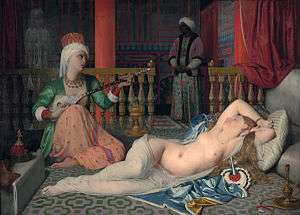Odalisque with Slave
| French: L'Odalisque à l'esclave | |
 | |
| Artist | Jean-Auguste-Dominique Ingres |
|---|---|
| Year | 1839 |
| Medium | Oil on canvas |
| Dimensions | 72.1 cm × 100.3 cm (28.4 in × 39.5 in) |
| Location | Harvard Art Museums/Fogg Museum, Cambridge, Massachusetts |
Odalisque with Slave (French: L'Odalisque à l'esclave) is an 1839 painting by Jean-Auguste-Dominique Ingres commissioned by Charles Marcotte. Executed in oil on canvas, it depicts a nude odalisque, a musician, and a eunuch in a harem interior. The painting is in the Fogg Art Museum in Cambridge, Massachusetts. It is a classic piece of Orientalism in French painting.
History
Ingres painted a number of harem scenes during his long career, starting with the Grande Odalisque (1814). These works exemplify a taste for Orientalist subject matter shared by many French painters of the Romantic era, notably Ingres' rival Eugène Delacroix. As Ingres never visited the Near East, Odalisque with Slave depicts an imaginary scene.[1] It was composed in Rome, where the artist lived from 1835 to 1841 while serving as director of the French Academy there.[2] The odalisque was painted from a life drawing Ingres had made years earlier.[3] The musician was painted from a model posed in the studio, and many details such as the tanbour were derived from engravings.[3]
Ingres labored over the execution with his usual great care, and enlisted some of his students as assistants. One of them was Raymond Balze, who wrote of his experience:
Ingres began his studies from nature and prepared the rough sketch on his canvas, then had made by his students the less important parts, very finished, such as the architecture, mosaics, rugs, furniture, instruments, which he often had [them] reposition, reluctantly [as he was] satisfied with their execution ... Then everything being finished with the figures, he alone undertook to harmonize the ensemble with onion skins of color.[4]

In September 1840 the painting was delivered to Paris, where it won praise from critics who viewed it in the owner's home. When exhibited publicly in 1845, the painting was widely admired, and written about by Baudelaire and Théophile Thoré-Bürger.[4]
Ingres made a second version in 1842 with the help of two of his students, Paul and Jean-Hippolyte Flandrin, which is at the Walters Art Museum in Baltimore. In this version the background wall, described by art historian Karin Grimme as imprisoning the odalisque in "a room with no exit",[5] was replaced with a garden painted by Paul Flandrin, inspired by the park at the Château de Dampierre.
The Louvre owns a carefully finished drawing Ingres made in 1858 that replicates the 1839 composition.[6]
Notes
References
- Boime, Albert (2004). Art in an Age of Counterrevolution, 1815-1848. Chicago: University of Chicago Press. ISBN 0226063372
- Cohn, Marjorie B.; Siegfried, Susan L. (1980). Works by J.-A.-D. Ingres in the Collection of the Fogg Art Museum. Cambridge, Mass.: Fogg Art Museum, Harvard Univ. OCLC 6762670
- Grimme, Karin H. (2006). Jean-Auguste-Dominique Ingres, 1780-1867. Hong Kong: Taschen. ISBN 3-8228-5314-3
- Prat, Louis-Antoine (2004). Ingres. Milan: 5 Continents. ISBN 88-7439-099-8
_-_Zelfportret_(1864)_-_28-02-2010_13-37-05.jpg)